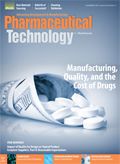Application of QbD and QRM to Analytical Method Validation
The article proposes an integration of method validation, transfer, and verification process into the overall lifecycle management process.
etrmalinak/shutterstock.com
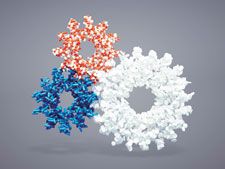
The US Pharmacopeial Convention (USP) released a general announcement on June 24, 2016, stating that a new General Chapter has been proposed, entitled, <1220> The Analytical Procedure Lifecycle, which will be consistent with the concepts of quality by design (QbD) as described in International Council for Harmonization (ICH) Q8 (R2), 9, 10, and 11 (1). In a Stimuli article published in Pharmacopeial Forum (PF) 39(5), the USP Validation and Verification Expert Panel discussed the application of lifecycle principles described in ICH Q8 to analytical procedures (2, 3). The article proposes an integration of method validation, transfer, and verification process into the overall lifecycle management process of the product to best align the variability of the analytical procedure with the requirements of the product. Incorporating the method procedure into the lifecycle change management process ensures that the procedure will remain suitable for its intended use. By using QbD concepts in the development and validation of the test procedure, an understanding of method variability-including variability of the test method and reference materials--can be developed, aiding in the understanding of total process variability such that it can be monitored, controlled, and reduced when possible.
As part of the lifecycle process, the panel suggests the establishment of an analytical target profile (ATP), which is similar to the concept of a quality target product profile (QTPP) and describes the criteria for a reportable result. Additionally, the article authors propose the application of quality risk management (QRM) concepts and tools from ICH Q9 to the development and validation of the analytical procedure (4). Suggested tools include process mapping tools to understand potential sources of impact to data quality, and evaluation tools such as the control, noise, experimental (C, N, X) technique. Design of experiment (DoE) studies can be used to evaluate those variables identified as experimental (X) to understand the acceptable ranges for these variables.
To further understanding of QbD concepts to analytical method development and validation, the tools suggested in the Stimuli article were combined with the guidance in ICH Q2(R1) (5) for this case study, and applied to the validation of a stability-indicating high-performance liquid chromatography (HPLC) method for Protopam drug substance (Baxter) and Protopam chloride for injection meeting ICH Q3A(R2) and ICH Q3B(R2) standards for impurities (6, 7).
Analytical target profile
Protopam chloride for injection is used as an antagonist to antichlolinesterases and is indicated as an antidote in the control of over dosage by anticholinesterase drugs and treatment of poisoning resulting from pesticides and chemicals in the organophosphate class that have anticholinesterase activity. It is supplied as a 1000 mg single-dose vial, which is reconstituted prior to injection (8). The maximum daily dose is 8 g. Based on the calculated maximum daily dose, the drug substance method must have a limit of quantitation (LOQ) ≤ 0.03% and drug product method must have an LOQ ≤ 0.05%. As the method was to be used for drug substance and drug product, the most critical performance criteria for the method was that the LOQ must be ≤ 0.03%, which is equivalent to ≤ 7.5 ng/mL for the test solution as prepared in the method. To meet the performance criteria, the ATP was established as the signal-to-noise ratio (S/N) for each injection of the LOQ solution (7.5 ng/mL) must be ≥ 10, and the percentage of relative standard deviation (RSD) for the peak area in the LOQ solution must be ≤ 20%.
Method development
The assay method from the current USP monograph for pralidoxime chloride was used as a starting point for method optimization (9). Multiple wavelengths were investigated and UV-Vis spectra of pralidoxime chloride and two related substances were obtained. There was no common λmax between the three related substances and pralidoxime chloride; therefore, the 270 nm detection wavelength specified appeared to be the best compromise for optimal sensitivity. Increased injection volumes were evaluated and multiple columns screened. A 50 µL injection volume and the Spherisorb ODS2 (Waters), 3 µm, 4.6 x 250 mm column, were selected for further development work (Table I). A preliminary evaluation of LOQ, repeatability, specificity, and linearity was conducted on four HPLC systems and two lots of stationary phase.
Table I: Initial optimized related substances assay conditions. Following design of experiment study, the triethylammonium chloride (TEA) concentration was increased to 0.5 mg/mL. ACN is acetonitrile.
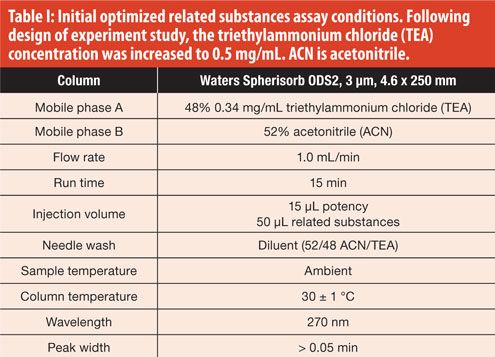
Risk assessment and analytical design space
Potential failure modes of the method were examined via discussions with experienced analysts. A fishbone diagram (Figure 1) was constructed.
Figure 1: Method failure cause fishbone diagram. (Courtesy of authors)
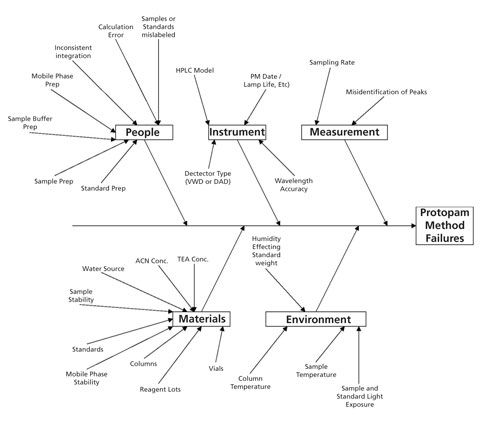
Potential failure causes were assessed using a CNX model (Table II) to identify those that could be controlled (C), those that were noise (N), and those that required experimentation (X). Instrument malfunction was not listed in the fishbone diagram or table. It must be controlled by system suitability requirements.
Table II: Control, noise, experimental (CNX) analysis.
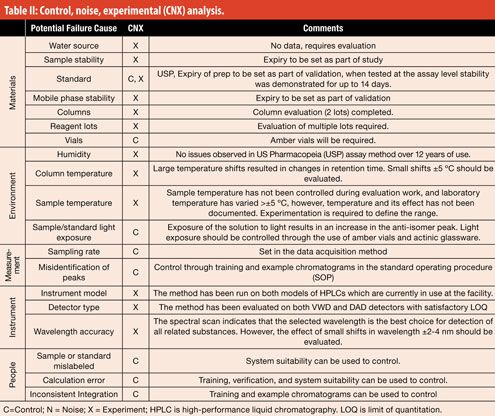
A failure mode effects analysis (FMEA) was conducted using the potential failure mode causes identified. A scale of 1 to 5 was used to rank the severity (S) of the failure, the probability (P) of the failure, and the likelihood that the failure would be detected (D) using the guide in Table III.
Table III: Severity, probability, and detectability rankings. LIR is laboratory investigation report.
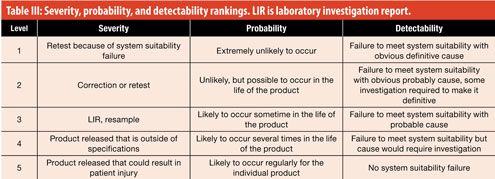
Risk assignment is summarized in Table IV. The risk assigned to each possible failure mode was calculated as: Risk = Severity X Probability X Detectability. The category C modes were all related to people and were not unique to the method. The potential failures must be mitigated by training, verification, good distribution practice (GDP), and other aspects of a quality system. The precision section of the method validation demonstrated that these potential failure sources were controlled at that period in time. The potential failure causes identified as N were related to small variations in sample and standard preparation, and were part of the variability to be tested in the intermediate precision section of the validation. The X failure modes were rank ordered in Table V.
Table IV: Risk assessment and control table. SOP is standard operating procedure. LOQ is limit of quantitation.

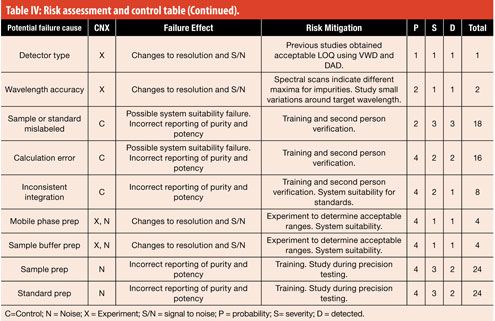
DoE robustness study design
The highest identified X risk was related to standard stability. Stability of the prepared standard was demonstrated for up to 14 days at the assay level in a previous study, but was not evaluated at the impurities level. Stability was assessed as a part of the validation study. The second highest identified risk was related to the risk that the standard or sample could absorb water during weighing. The standard and sample are dried at 105 °C for three hours prior to weighing. The tendency of the dried material to absorb water was evaluated in a simple experiment in which weight gain at ambient conditions was monitored. The average mass increased by 0.19% after four hours, and the method was updated to instruct analysts to weigh standards and samples immediately after removing them from the oven.
Table V: Potential failure causes for experimentation.
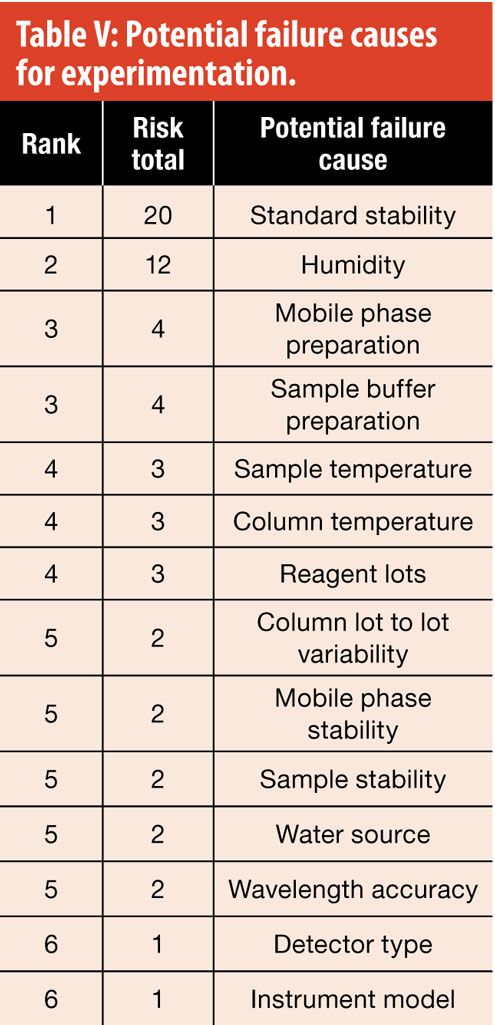
The remaining possible failure causes assigned ranked 3, 4, or 5 were evaluated using a DoE approach (Tables VI and VII). Additional chromatographic parameters such as flow rate and injection volume were added to provide a validated space for the method. A eighth fractional factorial design, consisting of 16 assay runs, was constructed in MiniTab to evaluate % acetonitrile (ACN) concentration of the mobile phase, the tetraethylammonium chloride (TEA) concentration in the sample buffer and mobile phase, the sample temperature, the column temperature, the wavelength, the flow rate, and the injection volume. The impact on ATP was assessed by reporting the S/N of the LOQ solution and the % RSD for the peak area in the LOQ solution. The precision of the impurity content and the assay value for the sample at each condition and overall was reported and evaluated. Following the execution of the original DoE study, an additional set of runs was added to explore the effect of higher TEA concentrations and higher wavelengths. The additional studies were intended to evaluate the effect of TEA hydrate form as well as compare variance between old and new columns and the variation between laboratories. All test runs included Protopam Chloride USP standard, Protopam Chloride drug substance, Protopam for Injection from a concluded stability study reconstituted and heat degraded at 80 °C for approximately 24 hours, and a LOQ solution.
Table VI: Parameters for chromatographic conditions design of experiment robustness study. TEA is triethylammonium chloride. ACN is acetonitrile.
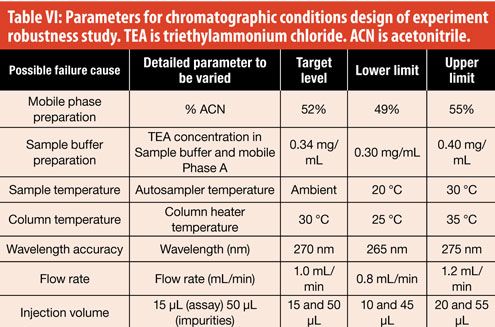
Table VII: Non-continuous parameters for robustness study. TEA is triethylammonium chloride.

DoE robustness study results
The factorial design was analyzed using MiniTab version 14, using both the LOQ S/N ratio and the % RSD of the peak area for the LOQ injection as the responses. Using the % RSD of the LOQ solution peak area as the response, no significant effects were observed; all factors and all interactions resulted in a response less than the p value. Using the average S/N of the six LOQ injections, two factors were determined to be significant (Figure 2). Both TEA and wavelength had p values greater than Alpha. A main effects plot (Figure 3) supported that TEA and wavelength are significant. S/N is greatest at 0.4% TEA and a wavelength of 275 nm. An interactions plot and surface plot indicated that there was no interaction between TEA concentration and wavelength.
Figure 2: Normal probability plot (left) and Pareto chart (right) of the effects for average signal-to-noise ratio (S/N) of the limit of quantitation (LOQ).
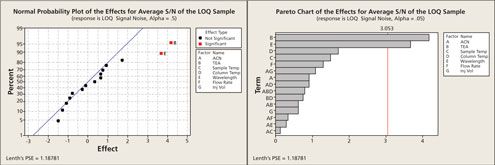
Figure 3: Main effects plot for average signal-to-noise ratio (S/N) of the limit of quantitation (LOQ) sample.
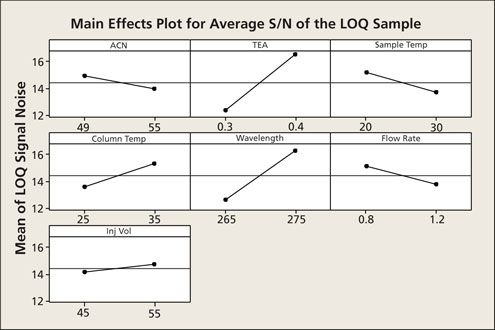
To understand if the LOQ solution S/N was optimized, an additional factorial study was executed adding a TEA concentration of 0.5% and wavelength of 280 nm to the study. The additional factorial required four more HPLC runs.
No significant improvement in the working LOQ solution S/N was obtained by increasing the TEA concentration to 0.5 mg/mL from 0.4 mg/mL. Concentrations of 0.3, 0.35, 0.4, and 0.5 mg/mL resulted in acceptable results for S/N of the LOQ, with higher S/N results obtained for TEA concentrations of 0.4 mg/mL and 0.5 mg/mL. Remaining studies used TEA concentrations of 0.4 mg/mL.
No significant improvement in the LOQ solution S/N was obtained by increasing the wavelength to 280 nm. In addition, previous studies conducted indicated that there was no single peak maximum in common among all known impurities, but that a wavelength of 270 nm was suitable for all. Wavelengths of 270, 275, and 280 resulted in acceptable results for Protopam chloride at the LOQ. To further understand the optimum wavelength, the combined data sets were reanalyzed evaluating the average total percent impurities as area under the curve (AUC) reported for the heat-degraded product sample. A simple scatter plot (Figure 4) of the % impurities as AUC versus wavelength indicated that the amount of impurities detected was reduced at higher wavelengths. Analyzing each data set individually within Minitab analysis software demonstrated that the detection wavelength did have a significant effect on the amount of impurities reported (Figure 5).
Figure 4: Percent impurities in the heat degraded product sample vs. detection wavelength.
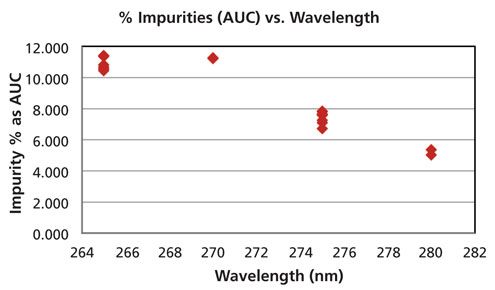
Figure 5: Normal probability plot and Pareto chart for % Impurities from the first factorial study (top) and second factorial study (bottom).
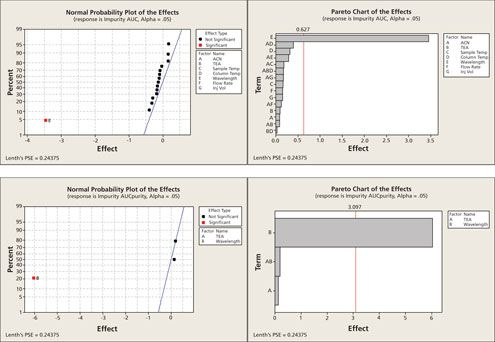
Additional experiments within the robustness study demonstrated that the method was sensitive to TEA type. Tetraethylammonium chloride monohydrate resulted in lower concentration than tetraethylammonium chloride, and the method was updated to specify the tetraethylammonium chloride form.
A review of DoE meeting the ATP was used to develop system suitability criteria for use in the validation study (Table VIII).
Table VIII: Proposed system suitability. USP is US Pharmacopeial Convention. RSD is relative standard deviation. STD is standard deviation.
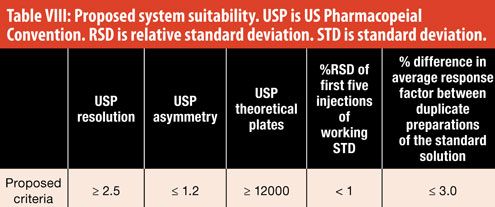
Method validation
The method validation was completed following standard procedures in accordance with ICH Q2(R1) and USP <1225> (5, 10). Linearity was demonstrated at assay and impurity levels. Precision was demonstrated for API and drug product. Accuracy was demonstrated through spiking studies, and specificity was shown through a forced degradation study. Robustness was repeated, for wavelength only, to understand if small, 2-nm variations would impact the related substances results. The LOQ was demonstrated as part of the precision study, and range was inferred from the linearity and accuracy results. Sample, standard, and mobile-phase stability were proven for up to seven days. All acceptance criteria were met.
Conclusion
The incorporation of QRM concepts and tools from ICH Q9 (4) to the development and validation of a stability indicating method for Protopam chloride for injection resulted in a robust procedure that met its ATP and all acceptance criteria during validation without deviation. DoE studies conducted following risk assessment established two variables that impact the ATP: the TEA concentration utilized for mobile phase and sample buffer and the detector wavelength. The improved understanding of the impact of sources of variability in method performance gained through the risk assessment and DoE study can be a valuable resource for future lifecycle change management process, ensuring that the procedure will remain suitable for its intended use.
References
1. USP, General Announcement-General Chapter Prospectus: <1220> The Analytical Procedure Lifecycle, June 24, 2016, www.usp.org/usp-nf/notices/1220-analytical-procedure-lifecycle, accessed July 25, 2016.
2. USP, “Stimuli to the Revision Process: Lifecycle Management of Analytical Procedures: Method Development, Procedure Performance Qualification, and Procedure Performance Verification,” Pharmacopeial Forum 39(5).
3. ICH, Q8(R2) Pharmaceutical Development (ICH, 2009), www.ich.org/fileadmin/Public_Web_Site/ICH_Products/Guidelines/Quality/Q8_R1/Step4/Q8_R2_Guideline.pdf, accessed July 25, 2016.
4. ICH, Q9 Quality Risk Management (ICH, 2005), www.ich.org/fileadmin/Public_Web_Site/ICH_Products/Guidelines/Quality/Q9/Step4/Q9_Guideline.pdf, accessed July 25, 2016
5. ICH, Q2(R1) Validation of Analytical Procedures: Text and Methodology (ICH, 2005), www.ich.org/fileadmin/Public_Web_Site/ICH_Products/Guidelines/Quality/Q2_R1/Step4/Q2_R1__Guideline.pdf, accessed July 25, 2016.
6. ICH, Q3A(R2) Impurities in New Drug Substances (ICH, 2006), www.ich.org/fileadmin/Public_Web_Site/ICH_Products/Guidelines/Quality/Q3A_R2/Step4/Q3A_R2__Guideline.pdf, accessed July 25, 2016.
7. ICH, Q3B(R2) Impurities in New Drug Products (ICH, 2006), www.ich.org/fileadmin/Public_Web_Site/ICH_Products/Guidelines/Quality/Q3B_R2/Step4/Q3B_R2__Guideline.pdf, accessed July 25, 2016.
8. Protopam Chloride (pralidoxime chloride) for Injection FDA Approved Labeling Text dated Sept. 8, 2010, , accessed 25 July 2016.
9. USP, Monograph for Pralidoxime Chloride, USP 39-NF 34.
10. USP, <1225> Validation of Compendial Procedures, USP 39-34.
Article Details
Pharmaceutical Technology
Vol. 40, No. 11
Pages: 46–55
Citation
When referring to this article, please cite it as W. Saffell-Clemmer and J. Karty, "Application of QbD and QRM to Analytical Method Validation," Pharmaceutical Technology 40 (11) (November 2016).
